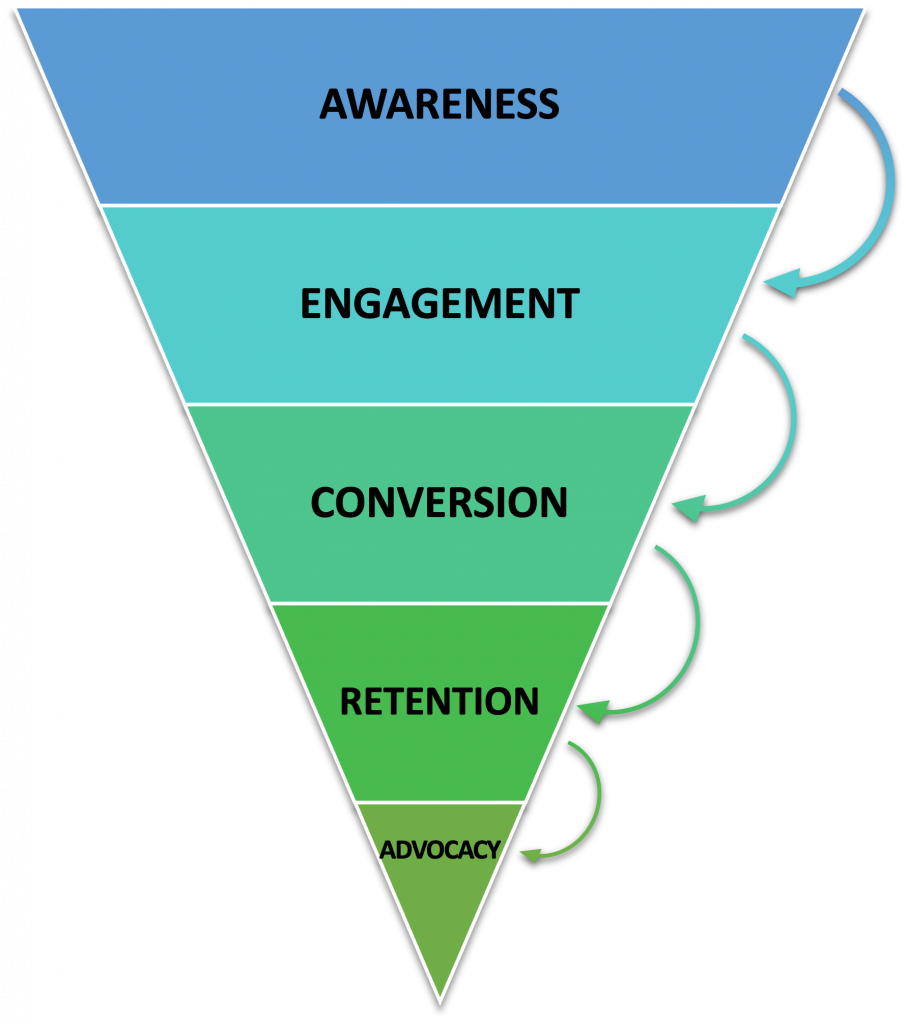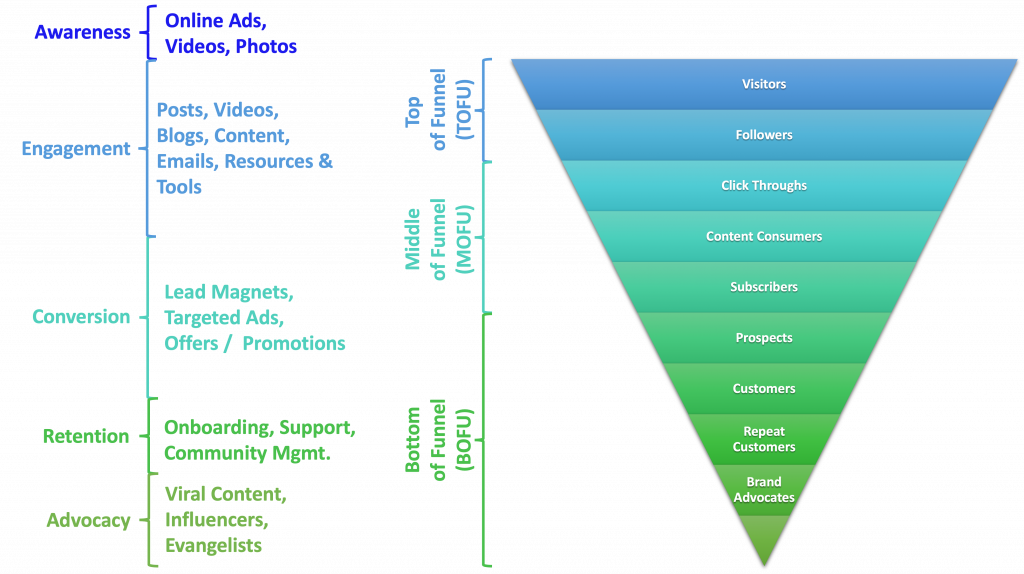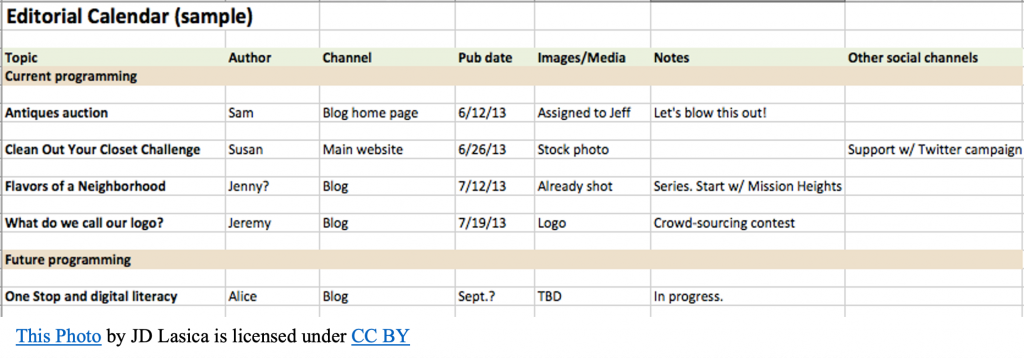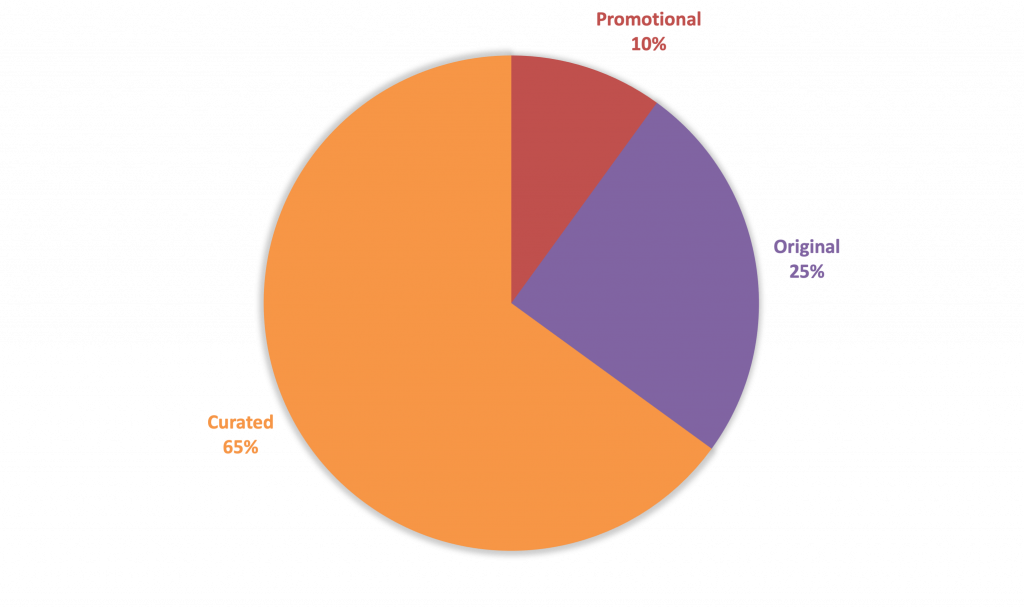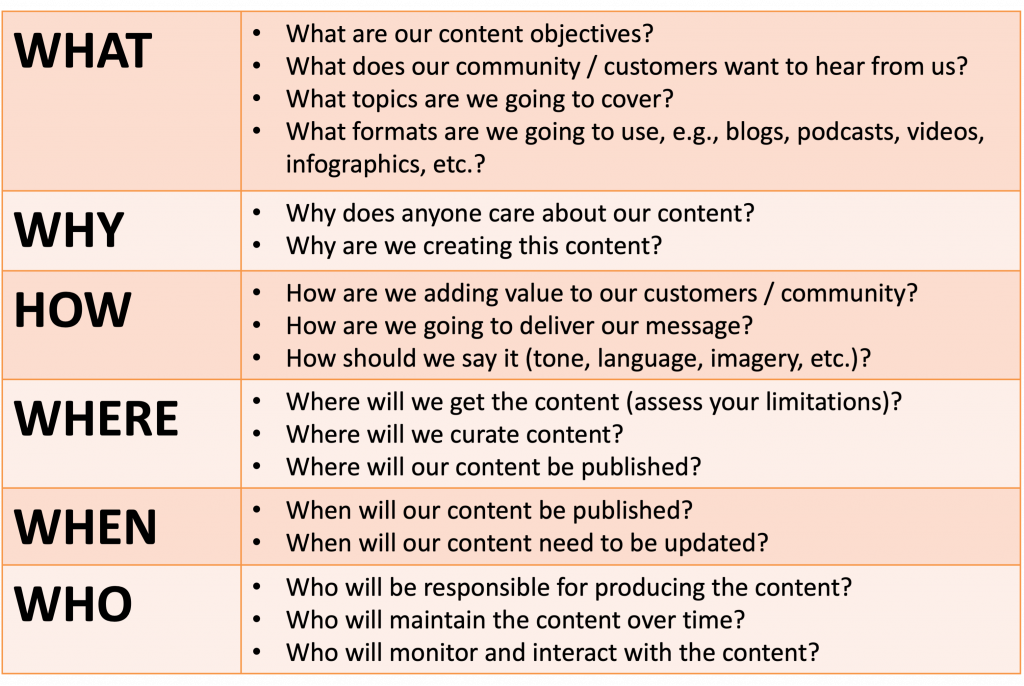2.2 Content Marketing
Learning Objectives
By the end of this chapter, you should be able to:
- Develop a content marketing strategy
- Map appropriate content types across your conversion funnel
- Explain the purpose of content calendars
- Describe several content marketing do’s and don’ts
Content Marketing and the Customer Journey
To start the discussion of content marketing, let’s first review some key concepts and how they tie into a content marketing strategy. As mentioned in the Customer Journey Mapping chapter, we have broken down the customer journey into the following five stages:
- Awareness
A prospective customer learns about an organization, product, or service.
- Engagement
A relationship develops between the prospective customer and the organization via several, positive interactions.
- Conversion
The prospective customer decides to buy a product or service from the organization.
- Retention
The customer has a strong and loyal relationship with the organization and becomes a regular customer or active user.
- Advocacy
A regular customer is satisfied with the organization’s products and/or services and recommends them to others.
Since organizations want to market to and support prospective customers at every stage of this journey, it is essential to plan specific content for each stage along this journey. The following image highlights different content categories as customers move through the customer journey.
On the left-hand side, we see the five customer journey stages – awareness, engagement, conversion, retention, and advocacy. And next to each of these stages, there are a few content categories that might be helpful to prospects and/or customers. For each stage, organizations should ask:
- What information is our target audience seeking?
- How can we best support / help them?
- Which pain points and questions can we address proactively?
- And how can we move them more quickly to the next stage?
Simply stated, as your target customers move through each of these stages, marketers need to identify the specific content that is most important at that stage. Please note that the content details and requirements will be significantly influenced by the type of organization, the customer persona, and the specific customer journey. But let’s look at some common types of content across a customer journey.
Top of Funnel (Awareness, Initial Engagement)
At the top of the funnel, organizations are usually trying to drive awareness. As a result, many of the goals associated with this stage include:
- increase traffic
- increase our social media fans and followers
- increase media coverage
To achieve these goals, organizations need to create and map content that matches the needs of customer personas in the awareness stage of a customer journey. Typically, this would include content that brings awareness of your organization, products, services, and solutions. Often this stage includes content like videos, paid ads, social media posts, etc.
Middle of Funnel (Ongoing Engagement, Secondary Conversions)
At the middle of the funnel, prospective customers are interested and considering their options. They are aware you exist but are seeking more information about your solutions and/or trying to better understand who you are and what you offer. These leads may have come from an advertisement, link in a post, forwarded email, etc. In this stage, marketers want to make sure to offer content like blog posts, articles, case studies, webinars, videos, etc. that highlight why your organization is the most qualified and why you offer the best solutions to meet the target customer’s needs.
Bottom of Funnel (Primary Conversion, Retention, Advocacy)
At the bottom of the funnel, you will have qualified marketing, sales, product, or services leads. These leads have expressed interest, have been engaging with your organization or content, but have not yet committed to your primary conversion – usually a paid purchase. At this stage, marketers want to create content that will create an incentive for leads to convert. This content might include targeted ads, specific email offers and messages, and other lead magnets that provide an opportunity to convert.
Also included in this stage are new and repeat customers because remember the bottom of the funnel does not end at the point of purchase but continues post-purchase to ensure satisfied customers and to develop brand advocates. Remember the importance of customer referrals from the last chapter. So, your content marketing strategy needs to continue to support your leads long after they convert. Every organization should encourage their customers to become brand influencers and advocates – in essence, to start marketing on the organization’s behalf and to become an unofficial sale force. The easiest way to seed these kinds of conversations is to provide content that customers can easily share with their own networks. However, do make sure that your customers are satisfied with their customer experience, and feel connected to the brand and the brand’s community. This is because viral content can go both ways and complaints tend to spread much faster than praises.
Content Strategy
To develop your content strategy, there are several questions you need to address. In answering these questions, you can ensure your content plan and activities meet the needs of your target audience and are sustainable by your marketing team and the organizational resources you have available. The following key questions answer the what, why, how, where, when, and who for any content strategy:
What
- What are our content objectives?
Your content objectives should tie in and support your overarching marketing and organizational objectives.
- What do our community and customers want to hear from us?
A content strategy is about promoting messages that your community and customers want to read, see, or hear. It is no longer about pushing brand messages unless those messages align with what your target audience finds interesting and wants to engage with. Remember it is not just about your organization; it is about your target audience in relation to your organization.
- What topics are we going to cover?
Spend some time listening to your target audience e.g., on social media, to see and hear which topics they find most engaging or are most passionate about. Your topics should be driven by your target audience and their preferences. That said, conduct a brainstorming session with your own team because they may have ideas, as well. Then, compare your list to what you discover with your target audience.
- What formats are we going to use, e.g., blogs, podcasts, videos, infographics, etc.?
Similarly, find out which content formats perform the best or get the most reactions (likes, shares, comments, etc.) from your target audience. Once again, this is not about your organization’s preferences, but rather the content preferences of the community.
Why
- Why does anyone care about our content?
Marketers need to be clear about why their target audience cares about the content being produced. Creating content for content’s sake makes no sense. Since there is so much content being produced and shared, marketers need to produce content that gets above the noise. In essence, what is the benefit to your target audience?
- Why are we creating this content?
Once you know why your target audience wants this content, ask if this content makes sense for your organization? The answer to this question should align with your goals and objectives and what you want your target audience to do.
How
- How are we adding value to our customers / community?
Again, being clear on the benefits your content will provide to your target audience is key. When there is value in the content, people will pay attention, share, and discuss that content. Your organization is also then seen as a valuable contributor the community. So, when you post or share content of value, the community will take notice.
- How are we going to deliver our message?
This question is a follow up to the content formats. For every piece of content, there is the content production side and the content delivery side. Make sure you know how to deliver your content to those places where your target audience is located.
- How should we say it (tone, language, imagery, etc.)?
Another benefit of listening to your target audience is learning about their language, tone, and imagery preferences. To be a part of their conversation, use similar vocabulary, tone, e.g., casual or formal, and imagery most commonly used.
Where
- Where will we get the content (assess your limitations)?
Many organizations create ambitious content plans. However, plan realistically keeping your content production capabilities in mind. For example, if you plan to distribute lots of videos, do you have people within your organization, who have the video production and editing skills to support this? If not, do you have a sizable video production budget to hire outside resources to complete some of these tasks? If that does not seem likely, you may want to reduce your video content plans and replace it with content that your organization can more easily produce. There are always trade-offs, but it is recommended to play to your organizational strengths.
- Where will we curate content?
One complaint that frequently comes up is the amount of time required to create original content. However, the majority of the content you share should not be original content, but rather content created by others. Marketers should be finding relevant content that is of interest to their target audience. Where does that content live? What other websites, communities, or news sites can we introduce to our community that they would find interesting?
- Where will our content be published?
While there may be many places to distribute your content, focus on the top 1-2 channels and do them well. Once you have built up a loyal following, consider expanding to other channels or platforms. Unless your organization has a very large team and large budget, managing a meaningful presence across several marketing channels can become quite challenging to maintain and sustain. And usually, the quality of the content and target audience interactions suffer when managing too many channels.
When
- When will our content be published?
Tactically, it is important to know when to publish content to get the most interactions and engagement. Again, listening to your target audience, reviewing your customer personas, as well as understanding the cadence of your target audience’s daily, weekly, monthly, and seasonal rhythms can be quite beneficial in knowing when to publish content. For example, if your target audience is mothers with young children, you may want to think about posting content in the evenings after the children have been put to bed. But, if you are targeting working professionals, you might want to post in the morning prior to the workday’s start or during lunch time when these workers might take a lunch break.
- When will our content need to be updated?
Another area marketers often forget to think about is updating of content. In today’s ever-changing markets, content can quickly become old and stale. However, updating content can provide an opportunity to present the information again in a new context or to a new audience. Think about developing a content review process and updating content with fresh eyes. Your content is an asset, and you should try to leverage it as much as possible.
Who
- Who will be responsible for producing the content?
As mentioned, producing content takes time. Make sure you have clearly outlined who is responsible for which part of the content production. More importantly, keep in mind that with multiple people involved, there may be dependencies. For example, if the graphics designers will be creating all the graphics for an article, by when do you need those graphics so that you can finish the article for the paid advertisement deadline?
- Who will maintain the content over time?
When planning for content to be updated, who will be responsible for making sure the content is properly maintained, e.g., making sure links are still working, etc.
- Who will monitor, interact, and support with the content?
Often marketers spend lots of time planning the launch and distribution of content, but who will interact with the community when people leave comments or ask questions? The goal of content marketing is to engage and interact with your target community. Make sure there is someone responsible for engaging with the community, being responsive, and managing the open dialog that content marketing sparks.
Content Calendars
Now, that you have a solid content strategy, you will need to create a content plan that highlights when content will be distributed, on which platforms, covering which topics, for which target audience(s), showing who’s responsible, and all the content production details. Typically, all of this information will live within a content calendar. Content calendars map out all the details related to the content that marketers plan to create. They are useful tactical tools because they can:
- Provide a comprehensive content overview
- List what needs to be done
- Highlight missing opportunities, e.g., if the content is all focused on the same target audience or the same format
The above image provides a simple example of a content calendar. As you can see, Excel or Google Sheets work well for this type of plan. However, there are many content calendar templates and here are two from Hubspot and Hootsuite:
- The Social Media Content Calendar Template Every Marketer Needs (Free Hubspot Template)
- How to Create a Social Media Content Calendar: Tips and Templates (Hootsuite)
You can also conduct a search on Google for content calendar and templates. While most templates cover the basic attributes for managing your content, there are a few areas you may want to make sure are included in your content calendar:
- Target Audience
Since you may be targeting different audiences, this is a nice way to see at-a-glance that you have a good mix of content targeting a variety of stakeholders / audiences.
- Content / Media Type
Be sure to add the type of media for your post: infographic, video, story, text post, audio, etc. This ensures you have a nice mix and that all posts are not the same type of content / media.
- Dependencies
In some cases, your post(s) may be dependent on someone else completing part of it or completing something else related to it. It’s good to write down these dependencies so that you know who needs to get what to you and by when.
- Content Themes / Topics
Many marketers may have common themes or topics that repeat on a regular basis, e.g., Trivia Tuesdays, Throwback Thursdays, Funny Fridays, etc. Categorizing your content this way, makes it easier to find and curate content that fits into the appropriate “bucket”. From a follower’s perspective, it also creates a pattern to your posts so that followers know what to expect and when.
- Comments / Notes
There may be some additional comments or notes you want to include. Give yourself a space to include these.
For marketers managing multiple marketing channels, you can either put all your content into one calendar or have multiple content calendars, e.g., a social media content calendar, email content calendar, blog post content calendar, conference calendar, etc. The choice is up to you to decide which system will work best for your team and organization.
Promotional vs. Original vs. Curated Content
One frequently asked question is how do I find time to create and manage all this content? This is perhaps the biggest misunderstanding about content marketing; the perception that all content must be original content. As mentioned before, the majority of content shared, should actually be from other sources. The above pie chart provides a guideline on content splits:
- Promotional (10%)
Promotional content refers to content that is trying to sell and/or heavily promote an offer and should be ~10% of all the posts distributed. This is because most people do not like being sold to all the time. Remember content marketing is about building relationships with your community and to do this, marketers cannot be selling all the time. If there is too much selling content, your target audience will simply stop listening.
- Original (25%)
Original content is content that your organization creates. As mentioned in the content strategy, you want to create original content that provides value and benefits to your target audience and that aligns with your organizational goals and objectives. However, original content takes time and money. It is also tempting to have original content focus on the organization. So, to limit your content marketing feeling too much like self-promotion, you will want to limit the number of posts that highlight your organization. Generally speaking, you want ~25% of your posts to be original.
- Curated (65%)
The bulk of your content should be curated content. Curated content is content created and distributed by others that is of interest to your target audience. This could be articles, market research, complementary products or services to your offerings, or any other content that your target audience might find of interest. By sharing content from others, you show your target audience that you are willing to share content produced by others and that you are also happy to share any content of value regardless of who produced it and give someone else credit for it. An important benefit of this strategy is that when you do post your own original content, the other content producers, whose content you have promoted, are more likely to reciprocate and share your content with their networks. Most importantly, this signals to your target audience that you are simply looking for the best content for them, regardless of the source.
Content Marketing Do’s and Don’ts
So far, we’ve talked about developing a content marketing strategy and plan. But what are tips and tricks to successfully launching a content marketing strategy? Here are few do’s and don’ts that build on many of the concepts and questions already discussed:
-
Do’s
- Add Value
Review your customer personas and customer journeys to make sure you are addressing the pain points, goals, and questions that your prospective and exiting customers have.
- Tell Stories
Apply the concepts and frameworks from the Fundamentals of Storytelling and Visual Storytelling chapters.
- Encourage Conversations / Discussion
Remember content marketing is merely a vehicle to learn more about your target audience, to engage with them, to find out what they are most interested in and passionate about, and to build longer term relationships.
- Experiment
Try a variety of different content formats, topics, etc. Marketers willing to experiment can sometimes stumble across some great discussions that lead to valuable customer insights and even viral sharing.
- Add Value
-
Don’ts
- Hard Sell
Again, no one likes communications to only be about selling. Mix up your messages to also include curated content and content that simply benefits the community.
- Be Generic
The details are the interesting parts. Your goals is not to be like everyone else; be unique and highlight how what you are offering and who you are is different from others in your industry.
- Ignore Your Community / Leads
Make sure to follow up and respond to messages from your community. Pay attention to your target audience and they will pay attention to you.
- Hard Sell
Developing Content / Lead Magnets
In the last chapter, we introduced the concept of lead magnets. Remember a lead magnet is a free item or service that is given away for the purpose of gathering contact details. Now that we have walked through how to build a content strategy and plan, you may want to think about incorporating lead magnets into your content plans. So, the following lists provide several examples of lead magnets in the various categories:
Summary
To successfully build your content strategy and plan, be sure to answer the following questions:
And using some of the lead magnet ideas from this chapter, map your content against the appropriate stages of your customer journey:
Key Takeaways
Content marketing can be a powerful strategic and tactical approach to connecting to and learning about target audiences.
- As target customers move through each of the five customer journey stages – awareness, engagement, conversion, retention, and advocacy – marketers need to identify the specific content that is most important at each stage.
- To develop your content strategy, marketers need to answer key what, why, how, where, when, and who questions to ensure their content plan and activities meet the needs of the target audience and are sustainable by the marketing team and the organizational resources available.
- Content marketing is not just about creating content, its goal is to build meaningful relationships with prospective and existing target audiences.
- The ideal content mix contains ~10% promotion content, 25% original content, and 65% curated content.
Content Marketing – Additional Resources
Here are some additional content marketing articles:
- 69 Highly Effective Lead Magnet Ideas
- Where to find 100+ Free Lead Magnet Templates
- 97 Amazing Freebie (Content Creation) Sites For Founders & Makers
- 13 Stock Video, Stock Image, and Stock Audio Resources for Creators and Marketers
- The Top 149 Social Network Open-Source Projects
- 10 Best Podcast Hosting Platforms
And, here are several free industry certifications related to content marketing:
- SEMrush Content Marketing Toolkit Course (3 hrs. – SEMrush)
- Content Marketing Fundamentals Course with Ashley Segura (2 hrs. – SEMrush)
- Hubspot Content Marketing Certification (6 hrs. – Hubspot)
- YouTube Creator Academy – Create Great Content (1 hr.)

